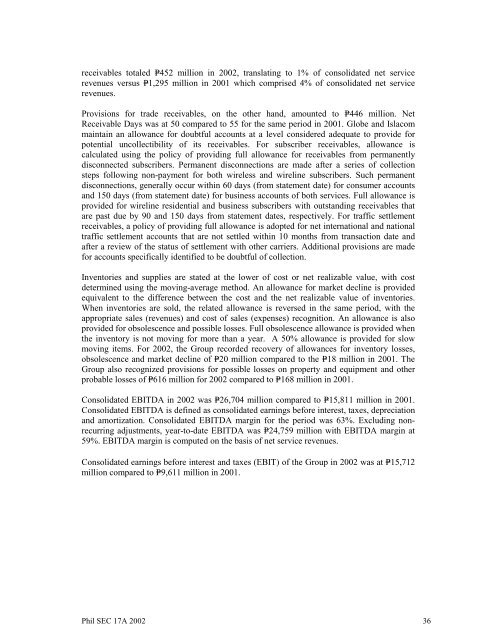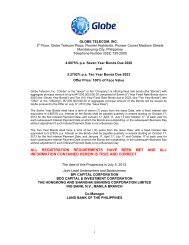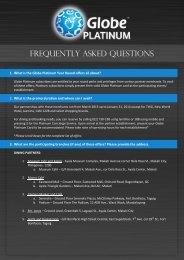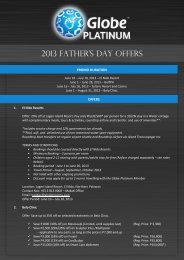formerly GMCR, Inc. - Globe
formerly GMCR, Inc. - Globe
formerly GMCR, Inc. - Globe
You also want an ePaper? Increase the reach of your titles
YUMPU automatically turns print PDFs into web optimized ePapers that Google loves.
eceivables totaled P=452 million in 2002, translating to 1% of consolidated net service<br />
revenues versus P=1,295 million in 2001 which comprised 4% of consolidated net service<br />
revenues.<br />
Provisions for trade receivables, on the other hand, amounted to P=446 million. Net<br />
Receivable Days was at 50 compared to 55 for the same period in 2001. <strong>Globe</strong> and Islacom<br />
maintain an allowance for doubtful accounts at a level considered adequate to provide for<br />
potential uncollectibility of its receivables. For subscriber receivables, allowance is<br />
calculated using the policy of providing full allowance for receivables from permanently<br />
disconnected subscribers. Permanent disconnections are made after a series of collection<br />
steps following non-payment for both wireless and wireline subscribers. Such permanent<br />
disconnections, generally occur within 60 days (from statement date) for consumer accounts<br />
and 150 days (from statement date) for business accounts of both services. Full allowance is<br />
provided for wireline residential and business subscribers with outstanding receivables that<br />
are past due by 90 and 150 days from statement dates, respectively. For traffic settlement<br />
receivables, a policy of providing full allowance is adopted for net international and national<br />
traffic settlement accounts that are not settled within 10 months from transaction date and<br />
after a review of the status of settlement with other carriers. Additional provisions are made<br />
for accounts specifically identified to be doubtful of collection.<br />
Inventories and supplies are stated at the lower of cost or net realizable value, with cost<br />
determined using the moving-average method. An allowance for market decline is provided<br />
equivalent to the difference between the cost and the net realizable value of inventories.<br />
When inventories are sold, the related allowance is reversed in the same period, with the<br />
appropriate sales (revenues) and cost of sales (expenses) recognition. An allowance is also<br />
provided for obsolescence and possible losses. Full obsolescence allowance is provided when<br />
the inventory is not moving for more than a year. A 50% allowance is provided for slow<br />
moving items. For 2002, the Group recorded recovery of allowances for inventory losses,<br />
obsolescence and market decline of P=20 million compared to the P=18 million in 2001. The<br />
Group also recognized provisions for possible losses on property and equipment and other<br />
probable losses of P=616 million for 2002 compared to P=168 million in 2001.<br />
Consolidated EBITDA in 2002 was P=26,704 million compared to P=15,811 million in 2001.<br />
Consolidated EBITDA is defined as consolidated earnings before interest, taxes, depreciation<br />
and amortization. Consolidated EBITDA margin for the period was 63%. Excluding nonrecurring<br />
adjustments, year-to-date EBITDA was P=24,759 million with EBITDA margin at<br />
59%. EBITDA margin is computed on the basis of net service revenues.<br />
Consolidated earnings before interest and taxes (EBIT) of the Group in 2002 was at P=15,712<br />
million compared to P=9,611 million in 2001.<br />
Phil SEC 17A 2002 36
















